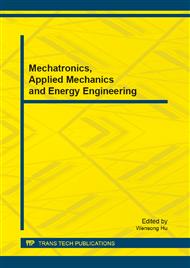[1]
X.L. Zhang, Q. Feng, P. Sun and W. Li: Characteristics of high gamma ray reservoir of Yanchang formation in Ordos basin, Chinese Journal of Geophysics, vol. 53 (2010), pp.205-213.
DOI: 10.1002/cjg2.1482
Google Scholar
[2]
R.P. Sorenson: A dynamic model for the permian panhandle and Hougoton fields, western Anadarko basin, AAPG Bulletin, vol. 89 (2005), pp.921-938.
DOI: 10.1306/03010504045
Google Scholar
[3]
M.L. Passaretti, E.V. Eslinger and G.D. Hinterlong: High gamma ray zone from a core within a Permian dolostone sequenc, SPE 15333. (1986).
Google Scholar
[4]
G.R. Li, Q.Y. Guo, Y.J. Shi and C.H. Li: Identification of high gamma ray reservoir in Ordos Basin, Well Logging Technology, vol. 30 (2006), pp.511-515.
Google Scholar
[5]
T. Zhang, C.Y. Lin, X.G. Zhang, J.F. Yu, X.R. Lu and X.X. Zhang: Genesis analysis of high GR reservoir and its well-log based recongnition method, OGP, vol. 47 (2012), pp.491-495.
Google Scholar
[6]
J.L. Zhao, C.Q. Tan, C.Y. Liu and Q.C. Li: Abnormity features of obvious natural gamma in Ordos Basin, Journal of Earth Sciences and Environmen, vol. 28 (2006), pp.83-86.
Google Scholar
[7]
P. Sun, X.L. Zhang, L. Guo and Y.B. Shen: Genesis of the sandstone with higher radioactivity and the qualitative evaluation of its reservoir property: taking Chang 6 oil-bearing strata in Zhidan Oilfield Ordos Basin as an example, Journal of Xi'an Shiyou University (Natural Science Edition), vol. 25(2010).
Google Scholar
[8]
C.J. Xue, G.X. Chi and W. Xue: Effects of hydrocarbon generation on fluid flow in the Ordos Basin and its relationship to uranium mineralization, Geoscience Frontiers, vol. 2 (2011), pp.439-447.
DOI: 10.1016/j.gsf.2011.05.007
Google Scholar
[9]
C.J. Xue, G.X. Chi and W. Xue: Interaction of two fluid systems in the formation of sandstone-hosted uranium deposits in the Ordos Basin: Geochemical evidence and hydrodynamic modeling, Journal of Geochemical Exploration, vol. 106 (2010).
DOI: 10.1016/j.gexplo.2009.11.006
Google Scholar
[10]
H. Yang, W.Z. Zhang and K. Wu: Uranium enrichment in lacustrine oil source rocks of the Chang 7 member of the Yanchang Formation, Erdos Basin, China, Journal of Asian Earth Sciences, vol. 39 (2010), pp.285-293.
DOI: 10.1016/j.jseaes.2010.03.013
Google Scholar
[11]
Z.F. Yu, R.H. Cheng, X.Q. Zhao, F.X. Sun, Z.J. Xu and Y.J. Shen: Genesis and identification of high gamma sandstone in the first member of of Nantun formation of Wunan depression in Hailar Basin, Journal of China University of Petroleum, vol. 36 (2012).
Google Scholar
[12]
Mohamed Chaker Raddadi, Annie Arnaud Vanneau, Gérard Poupeau, Elisabeth Carrio-Schaffhauser, Hubert Arnaud and Alice Rivera: Interpretation of gamma-ray logs: The distribution of uranium in carbonate platform, C.R. Geoscience, vol. 337 (2005).
DOI: 10.1016/j.crte.2005.08.009
Google Scholar
[13]
X. Xu, C. Cheng, T.F. Ding, X.Y. Liu and H.Q. Li: Discovery of lisa basalt northwestern edge of Junggar Basin and it's geological significance, Xinjiang Geology, vol. 26 (2008), pp.9-16.
Google Scholar
[14]
D.R. Han, F.Z. Bai and S.X. Liu: Regional prognosis criteria for the sandstone type uranium deposits in interlayer oxidation zone and their application in the east of Junggar basin, Xinjiang, Uranium Geology, vol. 11 (1995), pp.129-138.
Google Scholar
[15]
J. Wang and L.T. Du: Gas reduction: an important factor in the formation of Uranium deposits, Uranium Geology, vol. 11 (1995), pp.19-24.
Google Scholar
[16]
H.B. Cheng, G.Z. Xu, M.L. Yang, J.P. Wang, W.H. Li and J.P. Quan: Direct evidences for reduction of pitchblende by pitch in the sawapuqi uranium deposit, Xinjiang, Bulletin of Mineralogy Petrology and Geochemistry, vol. 26 ( 2007), pp.246-248.
Google Scholar
[17]
S.X. Ling and G. Wang: Discovery of interlayer oxidation zone sandstone-type uranium mineralization in Lower Tertiary and its significance, Dingshan area, Junggar basin, Xinjiang, Uranium Geology, vol. 19 (2003), pp.264-270.
DOI: 10.1016/j.oregeorev.2021.104557
Google Scholar


